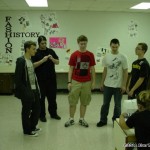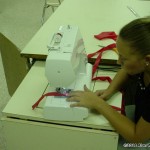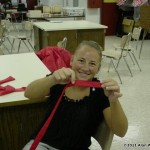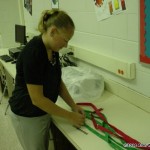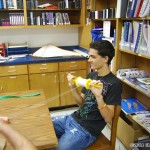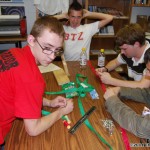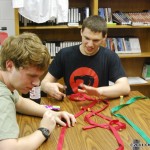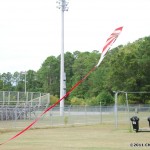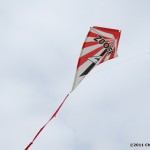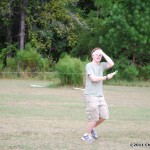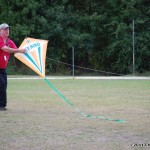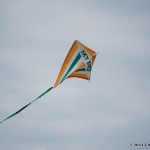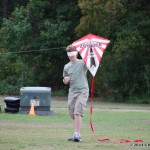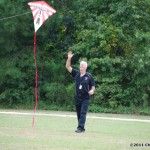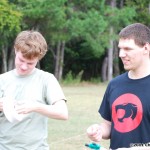An audio kiting experience for the sight impaired…
Photos by Christian Reynolds
I am the Media Specialist and Advisor for WASA (Waccamaw Association of Space and Aviation) club at Waccamaw High School in Pawleys Island, South Carolina and we joined up with Ms. Allyson Hossa who teaches Family and Consumer Sciences (Home Economics) at WHS to make kite tails for the blind. I have been flying kites ever since I was a kid like many other kite flyers. I’ve always loved to fly kites. I think it gives one a since of freedom, power, and dreams of flight. Why do this for blind children and adults? Well let’s consider this.
Junior, Taylor Beck; Sophomore, Evan Parrotta; Junior, Sam Welch;
Junior, Charles Julian; Junior, David Johnson and Teacher Ms. Allyson Hossa
I often think of the local country store that was located in Moore, South Carolina where my uncles Clayton Seay and his brother Guy ran “The Store”, is what they called it. I would often walk there or bike and buy one of those paper kites in a box full of diamond style kites for around 25 cents. Sometimes I would hit it lucky and find a box full of plastic kites that were more durable and last longer and were selling for about a buck twenty-nine. They would usually have a fancy design on the sail of the kite usually of a space theme or sky theme. Sometimes a tail would come with those babies but not often. In those days kite companies left it up to the kite flyer to provide the tails. I thought wouldn’t it be great for sight impaired children and adults to have some of these same feelings of kite flying that I had when I was a youngster.
Kite flying for most sight impaired people is a no brainer. If you can’t see it then you can’t fly it or can one? I wanted to make a kite audible. Not a breakthrough in science or something new to be done. Audible kites have been made ever since the kite was invented 3000 years ago by the Chinese. Different clans in China would tie noise makers to their kite tails to scare the enemy they were facing on the field. They also used noise makers on their kite tails at festivals for celebrations.
Ms. Hossa sews the experimental kite tails made of nylon.
Ms. Hossa shows students how to sew a jingle bell on a kite tail.
You’ll have to handle the rest guys.
Final adjustments are made for a perfect 11’ kite tail.
Thanks Ms. Hossa
I think our school would frown on explosives being attached to kite tails and with my little knowledge of pyrotechnics I probably would not have a kite if I used them anyway. So what then do we do to make our kites audible? Whistles would work, but I don’t have any, or even any idea as to where to get a good whistle for a kite tail. I do know to use the Internet for such things, and I do recall looking at one time, but they must have been expensive because I don’t remember much else about them. I was playing with the idea of attaching jingle bells to kite tails. I thought, why not, jingle bells can be found anywhere like Wal-Mart, Kmart, Target, well almost anywhere and they are not expensive. A few dollars spent and you’re in business.
With that said, how to put them on the kite tails and what size to use. This is where Ms. Hossa comes in from our school. With all the school cuts going on this day and age Ms. Hossa almost fell victim to them as well. It was told to us last spring that Ms. Hossa would not be coming back because of budget cuts. I spoke with another teacher about that. Carol Poole (Our Speech Pathologist) said that she doesn’t really remember anything from the SAT but she does remember the skills that she learned in Home Economics especially sewing. I thought if people didn’t know how to sew we would not have all the cool clothes to wear, shoes, car seats, etc. What about all those parachutes the military uses. Not to even mention we would have few kites because most kites today are sewn out of rip stop nylon and other durable materials for flight. No, we needed Ms. Hossa to teach kids how to sew and do all the other things they do in Home Econ. Well, our school district did see the need and found a way to keep Ms. Hossa. With this in mind I decided to give her a plug and announce in our school paper called, “The Weekly Warrior” how important her job is to our school and work for students in the future. I also wanted to show our students how sewing skills could be applied to a project to help the blind.
Time to work on the kite reel. Senior Ryan Murphy helps Mr. Pritchard change the line
on the reel taking the cheap stuff off and putting on the good 100 plus pound line.
Eleventh graders left to right: David Johnson, Charles Julian, Kyle Russell, Sam Welch
and Taylor Beck sew on jingle bells to the kite tails. Looks like fun.
Junior, Taylor Beck seems to be saying don’t mess with me while I’m sewing.
Thus, jingle bells was born. I decide to use one half inch silver jingle bells so I gave some to Ms. Hossa. Ms. Hossa worked on red and green nylon material making 11 foot long kite tails around one inch wide. The jingle bells were attached to each kite tail by WASA students (taught by Ms. Hossa to sew them on) about 14 inches apart to give it a good sound so that sight impaired people can enjoy the fun of kite flying. Flying a kite with jingle bells attached will open an opportunity for sight impaired children and adults so they may enjoy the world of kiting. WASA carried the kites and precious kite tails to the practice football field for testing.
Left to Right: Juniors Sam Welch and Charles Julian finish up the Jingle Tails.
Junior Sam Welch gets the experimental tail airborne. Excitement is in the air!
The old Zoomer paper kite came in handy when WASA could not find a suitable nylon kite for the experimental kite tail.
Mr. Pritchard took the paper kite down from the kite display in the Media Center that has been there for years. Many of the beach stores stop carrying kites for the season when the kite season never really goes out at the beach. Thus, the reason for not finding a suitable Eddy style nylon kite. WASA will find a couple of them to complete the project.
Coach Scott Streiffert (WASA Co-Advisor) gave the sign when to fly because he was monitoring the wind while I helped launch the kites with the experimental tails. The wind that afternoon was there one minute and gone the next. There was a lot of noise on the field with so many sports teams nearby and construction going on at school making hearing difficult. WASA stood by and listened for the sound. Junior, Sam Welch had on a blind fold to simulate a sight impaired person while flying the kite to find out if he could hear the jingle bells. Junior, Charles Julian flew the other jingle kite as WASA listened.
Sam had to peek at his kite that suddenly went down because of lack of wind.
Sam wore a blindfold so that he could simulate a sight impaired person flying a kite
and to see if he could hear the bells better trying to enhance his hearing.
Mr. Pritchard, dreamed up Jingle Tails to help the blind, helps Charles Julian get another Jingle Tail kite into the air.
Junior Charles Julian gets the experimental green tail into the air.
We did hear some ringing but not to the extent that we hoped. Coach Streiffert and I talked and agreed that putting fewer bells on the kite tails will allow more movement and more ringing. We may even put one larger one inch bell on the tail near the top. WASA will continue the project until the right combination of bells works out and may even look into other noise makers to attach to tails for sight impaired people.
Junior Sam Welch wanted to see if he could launch a kite blindfolded.
Coach Scott Streiffert (C0-Advisor to WASA), launches a kite into the air for Mr. Pritchard to fly.
Juniors Sam Welch and Charles Julian roll up the fun. Thanks guys. You helped make Jingle Tails a success.
WASA plans to give a completed jingle tail kite to one of our sight impaired students in Georgetown County. Mrs. Melissa Constable who works with hearing impaired children at our school gave me a contact for some sight impaired children. I called Ms. Angela Billiot from McDonald Elementary School in our District who works with sight impaired children who said that she had one child that we would get together with ASAP to fly. If our project is successful, and her child can actually fly the kite by listening to the bells for distance, WASA will give the kite with jingle tails to Ms. Billiot’s student and send another kite complete with jingle tails to the School for the Deaf and Blind in Spartanburg, South Carolina for other children to enjoy. Thanks Kitelife Magazine for caring about the kids with vision problems and let us both encourage kite companies to make and sell kite products for the blind so that all should enjoy flying a kite.
Alan W. Pritchard


